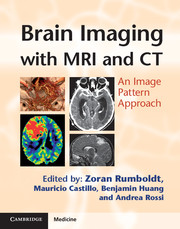Book contents
- Frontmatter
- Contents
- List of contributors
- List of abbreviations
- Preface
- Section 1 Bilateral Predominantly Symmetric Abnormalities
- Section 2 Sellar, Perisellar and Midline Lesions
- Section 3 Parenchymal Defects or Abnormal Volume
- Section 4 Abnormalities Without Significant Mass Effect
- Section 5 Primarily Extra-Axial Focal Space-Occupying Lesions
- 130 Arachnoid Granulations
- 131 Leptomeningeal Cyst
- 132 Epidural Hematoma
- 133 Subdural Hematoma
- 134 Empyema
- 135 Secondary (Systemic) Lymphoma
- 136 Idiopathic Hypertrophic Pachymeningitis
- 137 Olfactory Neuroblastoma
- 138 Meningioma
- 139 Desmoplastic Infantile Ganglioglioma
- 140 Hemangiopericytoma
- 141 Schwannoma
- 142 Arachnoid Cyst
- 143 Epidermoid
- 144 Aneurysm
- 145 Racemose Neurocysticercosis
- 146 Ependymal Cyst
- 147 Choroid Plexus Cyst
- 148 Choroid Plexus Papilloma
- 149 Intraventricular Meningioma
- 150 Central Neurocytoma
- 151 Ventricular Diverticula
- Section 6 Primarily Intra-Axial Masses
- Section 7 Intracranial Calcifications
- Index
- References
134 - Empyema
from Section 5 - Primarily Extra-Axial Focal Space-Occupying Lesions
Published online by Cambridge University Press: 05 August 2013
- Frontmatter
- Contents
- List of contributors
- List of abbreviations
- Preface
- Section 1 Bilateral Predominantly Symmetric Abnormalities
- Section 2 Sellar, Perisellar and Midline Lesions
- Section 3 Parenchymal Defects or Abnormal Volume
- Section 4 Abnormalities Without Significant Mass Effect
- Section 5 Primarily Extra-Axial Focal Space-Occupying Lesions
- 130 Arachnoid Granulations
- 131 Leptomeningeal Cyst
- 132 Epidural Hematoma
- 133 Subdural Hematoma
- 134 Empyema
- 135 Secondary (Systemic) Lymphoma
- 136 Idiopathic Hypertrophic Pachymeningitis
- 137 Olfactory Neuroblastoma
- 138 Meningioma
- 139 Desmoplastic Infantile Ganglioglioma
- 140 Hemangiopericytoma
- 141 Schwannoma
- 142 Arachnoid Cyst
- 143 Epidermoid
- 144 Aneurysm
- 145 Racemose Neurocysticercosis
- 146 Ependymal Cyst
- 147 Choroid Plexus Cyst
- 148 Choroid Plexus Papilloma
- 149 Intraventricular Meningioma
- 150 Central Neurocytoma
- 151 Ventricular Diverticula
- Section 6 Primarily Intra-Axial Masses
- Section 7 Intracranial Calcifications
- Index
- References
Summary
Specific Imaging Findings
On CT, there are no specific findings to distinguish between sterile and infected intracranial extra-axial fluid collections. Both may show peripheral contrast enhancement, although underlying brain edema is more common in infected ones. Sterile fluid collections nearly follow the CSF signal intensity on all MRI sequences. They may be slightly T1 bright depending on their protein contents. Both sterile and infected collections are of high signal on T2-weighted and FLAIR images and both may show peripheral contrast enhancement. DWIs are critical in reaching the correct diagnosis. Infected collections behave similar to brain abscesses with reduced diffusion (bright on DWI, signal lower than brain parenchyma on ADC maps). Occasionally, infected collections have a “dirty” appearance on T1- and T2-weighted sequences. It has been reported that DWI for the diagnosis of pyogenic infection following craniotomy is associated with a high false-negative and false-positive rate, especially within the epidural space. The absence of reduced diffusivity within a postoperative collection is therefore not sufficient to exclude infection.
Pertinent Clinical Information
Subdural empyemas are rare and generally found in young children who have underlying bacterial meningitis. In older children, most subdural empyemas (and epidural ones) are secondary to infections in the sinonasal and temporal bone cavities. In adults, the causes are similar but they may also be iatrogenic in nature. Extra-axial empyemas may irritate the cortex and produce seizures. Other complications include venous thrombosis (veins and sinuses) and arteritis leading to infarctions.
Information
- Type
- Chapter
- Information
- Brain Imaging with MRI and CTAn Image Pattern Approach, pp. 277 - 278Publisher: Cambridge University PressPrint publication year: 2012
